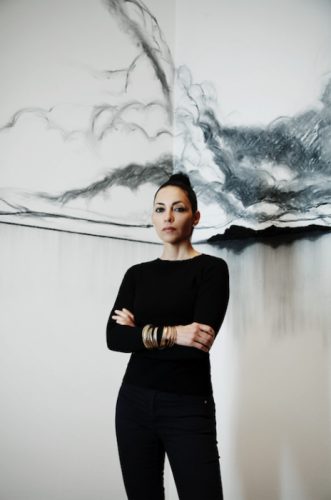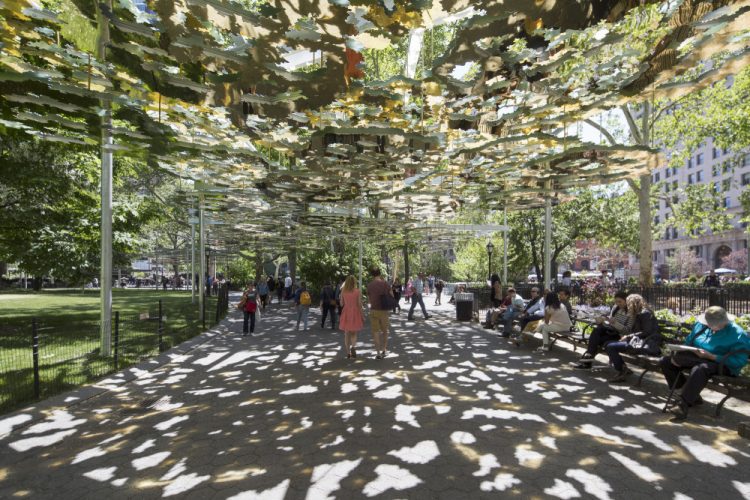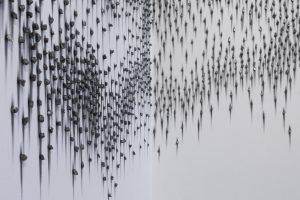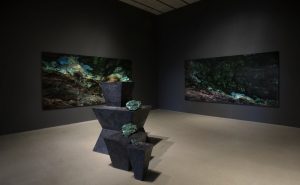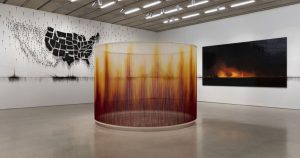FIU alumna, Teresita Fernández, has brought her biggest exhibition back to her hometown of Miami with “Elemental” now being showcased at the Perez Art Museum Miami (October 18, 2019-February 9, 2020). The art exhibit by the American Latinx conceptual artist is nothing short of a masterful composition of sculptures and drawings that have been seldom seen. Some parts of the series within the exhibition such as Fire (United States of America) (2017-2019) and Viñales (2015-2019), challenge their audiences by addressing the political climate and social topics. On Saturday, November 9, Teresita and the Perez Art Museum Miami invited our Art+Art History MFA/BFA students and staff to view the new exhibit and receive a personalized tour featuring Teresita, herself. Afterward, Teresita sat with Dr. Ana Dopico for a conversation and open discussion with audience members. Throughout the discussion, Teresita spoke on a variety of topics including, achieving a sense of identity through art, the pains of establishing herself in Miami and around the world, and growing up in the Miami area.
CARTA News was able to ask Teresita some questions to really get to know who she is and her hopeful intentions through the exhibit;
What does it mean to you to be able to bring your biggest exhibition, “Elemental”, back to your home of Miami? How did the culture at the time of your upbringing in Miami play into your identity as a Latinx artist? Being a first-generation college grad, what do you hope to achieve in the Latinx community by bringing your exhibition back to Miami?
I have lived in Brooklyn, NY since 1998 but much of my visual thinking was formed in the Miami landscape where I grew up. Miami can be visually arresting, almost surreal. When I was a child, Miami didn’t have any museums, but I occasionally saw art in people’s homes: a small-scale Wifredo Lam, or an Amelia Pelaez painting, and through books. So, it is especially satisfying to come back and see the important presence that contemporary art now has there, and to be able to exhibit my mid-career survey in a world-class museum in the town I grew up in. I’ve been fortunate to sustain a viable art practice for more than twenty years, but in general, people have a hard time perceiving an individual as both “excellent” and Latinx. Artists of color experience very different challenges in the art world. We live in a country founded on deeply-rooted anti-Latinx, anti-immigrant, and anti-Black sentiments and practices. In my work, I’m interested in unraveling these complexities of place and identity through beauty, materiality and experiential, visual, immersive prompts.
While I’m outspoken and proud of my Latinx identity as a conceptual artist, I am very much working from the specific and personal, so I reject any simplistic stereotypes and preconceived notions that have absolutely nothing to do with my work. There are almost no models for being a U.S. Latinx contemporary woman artist with visibility in the mainstream art world—one who also claims her ethnicity, without having to choose either/or. The constant need to choose between one’s artistic integrity and representing identity for others, coupled with the lack of examples of Latinx artists in American museum collections, points to larger issues of institutional racism, whitewashing, and inequity in our museums and art-history narratives, or what gets to be called “American art”.
What pathways did you take to reach the level of success you’ve achieved today, and how has your time at FIU played a role in your journey thus far?
After I finished graduate school, I spent some years traveling and doing artist’s residencies in Rome, at the American Academy, and then in Japan – a place that helped shape my particular way of seeing the world. I ended up in New York for another artist residency and just never left. There is always the external, fetishized, and romanticized idea of “success”, and then the quiet, less visible, inner one. Paying close attention to the inner one is what matters. The answer, the next step, is always in the work itself. There is no shortcut or formula. What externally gets read as “success” is actually grounded in a slow, decades-long studio practice that I’ve nurtured and protected.
How did it feel to have current students from your Alma Mater (FIU) come out to support and learn from you at your exhibition in the PAMM?
To young Latinx students at FIU, I would say, you are the future, and poised to become the largest, most influential demographic in this country. In many ways, this exhibition is a momentous opportunity to shape the context around my work and to shed light on the nuanced visual, art-historical, conceptual, personal, and sociopolitical intentions that are subtle, but nevertheless, very deliberate in my work – without having to choose one mode over another. I think being an artist means making your own way, and that defining what that looks like to you happens precisely by working, doing, paying attention. It’s not something someone can help you with or teach you to do. In great part, what I am able to offer to students is the important act of simply being visible; of not being erased or omitted, of taking up space, of having my work headlining a major museum show, of showing a decades-long practice of creating from the point of view of a Latinx woman with a history not unlike their own. This notion, of seeing someone who looks like you with a name and history like yours is, sadly and deliberately, not something taught in their art history classes, or seen as a valuable part of the canon for what constitutes art history. Being able to imagine that you can create, have impact, see yourself in museums, and be a defining part of shaping the story of art that has been denied to many people like you is, in itself, a radical act.
Congratulations on your incredible and continuous success Teresita! For more on her work and return to Miami, click here.

